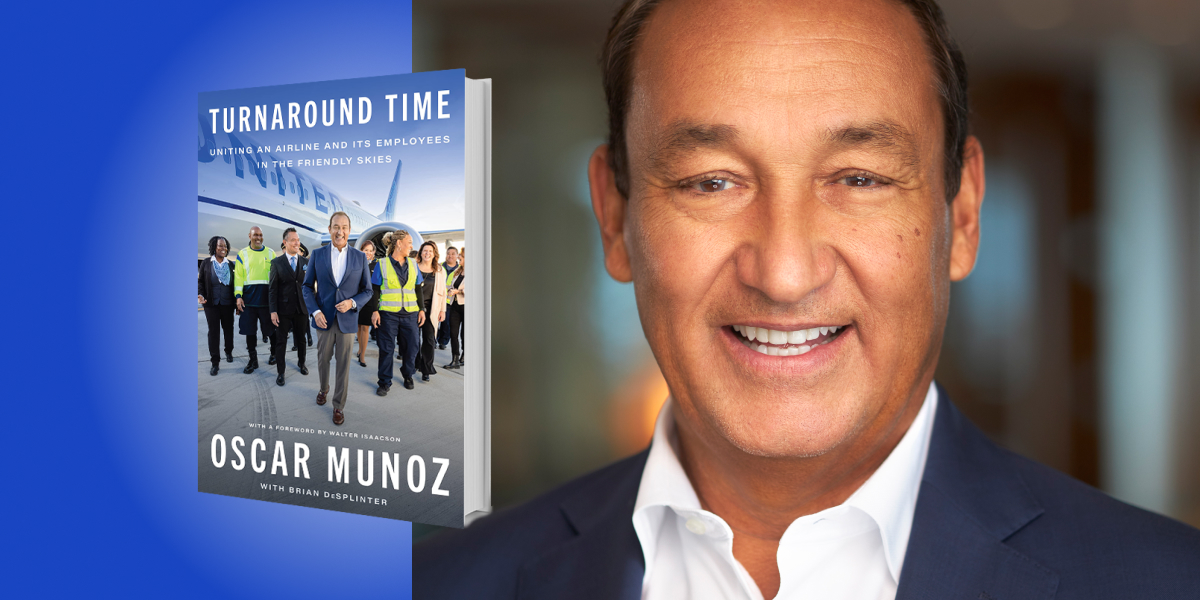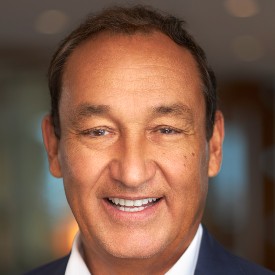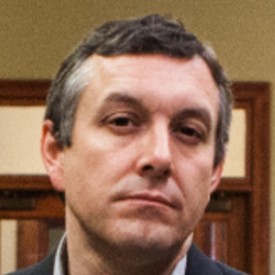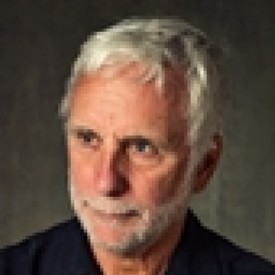Oscar Munoz was Chairman and CEO of United Airlines and is currently a member of the board of trustees of Fidelity Investments and a Member of the Board of Directors of Salesforce. He previously held several executive leadership positions at CSX, AT&T, US West, PepsiCo, and Coca-Cola. To date, he remains the only person of Hispanic heritage to run a US airline.
Below, Oscar shares five key insights from his new book, Turnaround Time: Uniting an Airline and Its Employees in the Friendly Skies. Listen to the audio version—read by Oscar himself—in the Next Big Idea App.
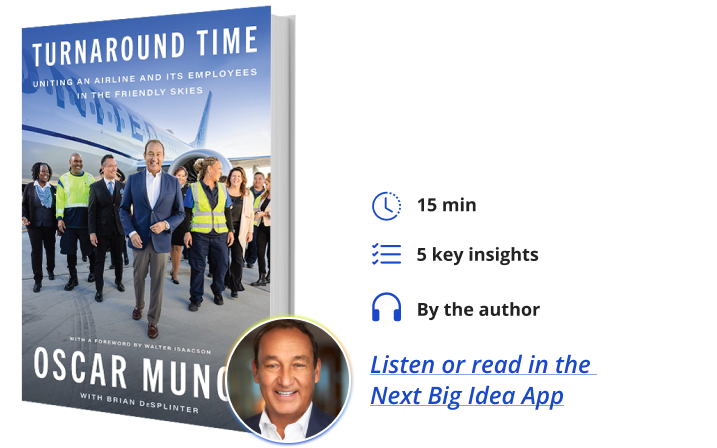
1. Listen and learn; only then, can you lead.
When I took over control of United Airlines, it was anything but united. If anything, it was facing serious headwinds. We lagged behind on financial and operational performance and faced a fraught merger with Houston-based Continental. Tortured contract negotiations with unions meant our employees still couldn’t fly on common metal; that’s airline parlance meaning not all crews could work together on the same flight. All of this dragged down the service we offered our customers.
If you’ve ever taken part in a corporate turnaround situation, you know there’s never a shortage of things to fix. In fact, almost everything is normally broken. The question is always what to fix first, but it’s simply a matter of sequencing and timing. My instinct was to get out of the confines of the C-Suite and launch a listening tour across our network. On the last day of the tour, I found the key insight while chatting with a flight attendant on a flight from Denver to Chicago. She burst into tears and said, “Oscar, I’m just tired of always having to say I’m sorry.”
I instantly understood what she meant and knew all of our colleagues would as well. We had placed our employees in an impossible position, always having to apologize for things over which they had no control: they were disenchanted, disengaged, and disenfranchised. We had to win back our employees’ morale before we could ever hope to win back our customers and investors. This simple but powerful insight was one that I could never have discovered while sitting behind my desk in the corner office.
2. Ask your team, “What are the ten dumbest things we do?”
This question was posed across our entire organization. The higher up in the organization chart it went, the fewer direct answers were given. The closer to the frontline, however, the answers became much clearer. Very often, topping the list were the smaller and easier items to fix. For example, you’d never believe how far a good cup of coffee will go toward earning goodwill.
“The closer to the frontline, however, the answers became much clearer.”
On board our aircraft, we had severed our relationship with Starbucks and switched to a cheaper brand of coffee. It may seem like a small, insignificant decision, but in fact, it was the “stirring straw” that broke the camel’s back—or at least it seemed to. It sparked a rebellion among frontline employees, especially veterans who remembered with fondness the days of high-quality offerings. “I simply won’t serve it,” said one flight attendant to a member of my team. I’m not a coffee drinker and so I wouldn’t know good coffee from bad, however, the whole episode left a bitter taste in my mouth.
Why should customers remain loyal to United when our product resembles that of a budget carrier? Why should employees take pride in serving a substandard product at all? At best, the downgrades sent a mixed signal; “care for the customer in the field,” we seemed to be telling employees while asking them to watch as we cut back on the resources necessary for you to do it. In the end, the savings from these efficiency drives were measly, which only proved how cheaply the company had been prepared to trade brand reputation and employee morale. By the end of my first year, we’d made a significant investment in our onboard offerings, boosting our frontline’s confidence. Employees interpreted these improvements as signs of what I call “proof, not promise,” convincing them I could tackle the bigger items on the list as well.
3. Locate your organization’s North Star.
Since ancient times, the North Star—or Polaris—has guided mariners to steer a better course. While waiting for my doctors to tell me they’d found a compatible heart transplant, I focused myself on aligning our team toward a common goal. For far too long, I felt our leadership team had become like nomads wandering in the desert, each pursuing their own goals, often working at cross-purposes.
I had recruited the expertise of the strategic advisory firm, Consequent, led by my friend Jack Bergstrand. His process was aimed at evaluating and strengthening leadership teams, advising them on how to assess the capabilities of individual members and tie them together to move forward in a unified way. I give great credit to our senior leaders who took part in this advisory process for carefully and honestly evaluating their own strengths and one another’s. This is an exercise that I advise all leaders to undertake within their own leadership teams.
“His process was aimed at evaluating and strengthening leadership teams, advising them on how to assess the capabilities of individual members and tie them together to move forward in a unified way.”
At a crucial off-site meeting, we finally arrived at a clearer understanding of how our team could work towards a common purpose. As fate would have it, just as this pivotal meeting wrapped up, I got a call from my heart doctor. “Oscar,” he said buoyantly, “I’ve got a kick-ass heart for you.” I slid my chair out from the table, stood up, and said, “Folks, thank you very much. I’m going to head back to the hospital for . . . something we’ve been waiting for.” Hoping they didn’t guess what was about to happen, I said, “I’ll see you on the other side.” Oddly, I wasn’t worried, but actually very calm, knowing that whatever happened to me, the team would find their way.
4. Trust is the coin of the realm.
I returned from my heart transplant surgery in March of 2016. Upon my return, I was met with a set of demands from institutional investors regarding our board of directors, some of which I rejected because I believed it would steer United in the wrong direction.
My effort to defuse a potential proxy battle led to some very tense negotiations. That was when my union leader counterparts stuck their necks out and voiced unequivocal support for me and the direction that I had communicated during that initial listening tour. They did so even though we still had huge mountains to climb in our negotiations, including for the flight attendants. From getting the small things right, like coffee, to the big things like contracts, a surplus of trust had become my saving grace. Trust is a commodity that resists an easy valuation, but when you need it, it’s priceless.
5. Trust your heart.
Heart disease remains the number one cause of death in the United States. If it happens to you outside of a hospital, you have a one in ten chance of surviving. Like more than half of all heart attack patients, the sudden cardiac arrest that nearly ended my life one fateful morning arrived with no advance warning or prior symptoms. As with the more than 70 percent of people who are mistakenly assessed as “low risk” by traditional measures, my blood work gave me no reason to pursue further checkups that might have detected the clot earlier.
What saved my life was remembering the words that a friend of mine, a heart surgeon, had recently said to me. “If you ever feel weird, don’t hesitate; just call 911. If you’re lucky, the worst that happens is you feel foolish for a false alarm.” I devote so much time and treasure to advancing the mission of the American Heart Association, to raise funds and raise awareness about the heart threat that too many of us ignore. So, my final insight is: trust your heart, and if you feel something, make a call to 911.
To listen to the audio version read by author Oscar Munoz, download the Next Big Idea App today:












